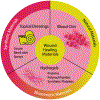Synthetic hydrogels as blood clot mimicking wound healing materials
- PMID: 35822083
- PMCID: PMC9273113
- DOI: 10.1088/2516-1091/ac23a4
Synthetic hydrogels as blood clot mimicking wound healing materials
Abstract
Excessive bleeding-or hemorrhage-causes millions of civilian and non-civilian casualties every year. Additionally, wound sequelae, such as infections, are a significant source of chronic morbidity, even if the initial bleeding is successfully stopped. To treat acute and chronic wounds, numerous wound healing materials have been identified, tested, and adopted. Among them are topical dressings, such as gauzes, as well as natural and biomimetic materials. However, none of these materials successfully mimic the complex and dynamic properties of the body's own wound healing material: the blood clot. Specifically, blood clots exhibit complex mechanical and biochemical properties that vary across spatial and temporal scales to guide the wound healing response, which make them the ideal wound healing material. In this manuscript, we review blood clots' complex mechanical and biochemical properties, review current wound healing materials, and identify opportunities where new materials can provide additional functionality, with a specific focus on hydrogels. We highlight recent developments in synthetic hydrogels that make them capable of mimicking a larger subset of blood clot features: as plugs and as stimuli for tissue repair. We conclude that future hydrogel materials designed to mimic blood clot biochemistry, mechanics, and architecture can be combined with exciting platelet-like particles to serve as hemostats that also promote the biological wound healing response. Thus, we believe synthetic hydrogels are ideal candidates to address the clear need for better wound healing materials.
Keywords: blood clot; hydrogel; wound healing.
Figures






Similar articles
-
Anti-Swelling, Robust, and Adhesive Extracellular Matrix-Mimicking Hydrogel Used as Intraoral Dressing.Adv Mater. 2022 May;34(20):e2200115. doi: 10.1002/adma.202200115. Epub 2022 Apr 14. Adv Mater. 2022. PMID: 35128734
-
Nature-Derived Polysaccharide-Based Composite Hydrogels for Promoting Wound Healing.Int J Mol Sci. 2023 Nov 24;24(23):16714. doi: 10.3390/ijms242316714. Int J Mol Sci. 2023. PMID: 38069035 Free PMC article. Review.
-
Design Considerations for Hydrogel Wound Dressings: Strategic and Molecular Advances.Tissue Eng Part B Rev. 2020 Jun;26(3):230-248. doi: 10.1089/ten.TEB.2019.0281. Epub 2020 Feb 28. Tissue Eng Part B Rev. 2020. PMID: 31928151 Review.
-
Hydrogels in Cutaneous Wound Healing: Insights into Characterization, Properties, Formulation and Therapeutic Potential.Gels. 2024 Mar 8;10(3):188. doi: 10.3390/gels10030188. Gels. 2024. PMID: 38534606 Free PMC article. Review.
-
Exploring the recent developments of alginate silk fibroin material for hydrogel wound dressing: A review.Int J Biol Macromol. 2023 Sep 1;248:125989. doi: 10.1016/j.ijbiomac.2023.125989. Epub 2023 Jul 25. Int J Biol Macromol. 2023. PMID: 37499726 Review.
Cited by
-
Biomimetic Hydrogel Strategies for Cancer Therapy.Gels. 2024 Jun 30;10(7):437. doi: 10.3390/gels10070437. Gels. 2024. PMID: 39057460 Free PMC article. Review.
-
A Prospective, Single-Arm Study to Evaluate the Safety and Efficacy of an Autologous Blood Clot Product in the Treatment of Anal Fistula.Dis Colon Rectum. 2024 Apr 1;67(4):541-548. doi: 10.1097/DCR.0000000000003190. Epub 2023 Dec 27. Dis Colon Rectum. 2024. PMID: 38149981 Free PMC article.
-
Structural control of fibrin bioactivity by mechanical deformation.Proc Natl Acad Sci U S A. 2022 May 31;119(22):e2117675119. doi: 10.1073/pnas.2117675119. Epub 2022 May 25. Proc Natl Acad Sci U S A. 2022. PMID: 35613056 Free PMC article.
-
A Brief Review on Cerium Oxide (CeO2NPs)-Based Scaffolds: Recent Advances in Wound Healing Applications.Micromachines (Basel). 2023 Apr 17;14(4):865. doi: 10.3390/mi14040865. Micromachines (Basel). 2023. PMID: 37421098 Free PMC article. Review.
-
Hydrogels and Wound Healing: Current and Future Prospects.Gels. 2024 Jan 5;10(1):43. doi: 10.3390/gels10010043. Gels. 2024. PMID: 38247766 Free PMC article. Review.
References
Grants and funding
LinkOut - more resources
Full Text Sources
